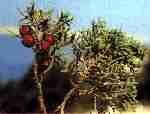
Shoots and fruits (2).
Common Names
Phoenician juniper (2), genévrier Phénicie (French).Taxonomic notes
Syn: J. canariensis, J. oophora (1); J. bacciformis Carr.; J. tetragona Moench. (2).Forma megalocarpa Maire differs from the type in having larger, purplish-brown fruits. Morocco: on the Atlantic coast (2).
Description
"A shrub or a small tree up to 6 (10) m high. Crown dense, conical. Bark dark brown. Shoots very slender, about 1 mm in diameter, roundish. Foliage scale-like, and needle-like on young plants; scale-like leaves ovate to rhombic, closely appressed, opposite or in whorls of 3, dark or blue-green, 1 mm long; needle-like leaves in whorls of 3, about 6 mm long, with 2 stomata bands on both the upper and lower surfaces. Monoecious or dioecious species. Fruit globose, about 1 cm across, glossy, yellowish or reddish-brown, slightly pruinose, on a stalk about 5 mm long, ripening in the second year, composed of 6 to 8 scales, with 3 to 9 seeds" (2).Range
Mediterreanean region and Canary Islands. "In North Africa it occurs on hills and dunes and in arid mountain regions ascending to 2200 m. In European area of the Mediterranean it grows up to 1200 m elevation. In Yugoslavia it occurs in the coastal region" (2).Big Tree
Oldest
"It attains over 1000 years of age" (2).Dendrochronology
Ethnobotany
Observations
Remarks
Citations
(1) Silba 1986.(2) Vidakovic 1991.
[Juniperus] [Cupressaceae] [home]
This page is from the Gymnosperm Database
URL: http://www.geocities.com/RainForest/Canopy/2285/cu/ju/phoenicea.htm
Edited by Christopher J. Earle
E-mail:earlecj@earthlink.net
Last modified on 21-Dec-98